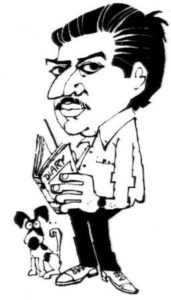India’s western beachfront state Goa has been busy with celebrations to mark the 90th birth anniversary of one of the country’s best-known cartoonists and illustrators, Mario Miranda. And why not? The Goans and Anglo-Indians, and the Bandra Bombayites all grew up on his captivating caricatures of our communities.
Mario’s warm-hearted, often comic drawings of local characters and culture helped to popularise his native state, Goa, both across India and overseas. He died in 2011.
The Mario Gallery and Museum has published Miranda’s 1949 diaries, which depict his student life as a 22-year-old in the city of Mumbai.
A free musical concert, and an exhibition of 74 of his original and print works are on display at an art gallery in Goa’s capital Panjim, as part of the celebrations.
Though born in Goa, Mario, as he was popularly known, (self-portrait, above) spent his youth shuttling between Mumbai and Goa.
He worked as a cartoonist in newspapers like the now-defunct Current and later with the Illustrated Weekly of India magazine, besides Midday and later, Economic Times. The Afternoon Dispatch and Courier produced some of his best work on the city.
That period also saw Mario create the endearing characters of his cartoons – the secretary Miss Fonseca, the minister Bundaldass, and Bollywood star Rajani Nimbupani (above).
“Mumbai, seen through Mario Miranda’s eyes, is at one level cosmopolitan, symbolising the good things in life, and at another level, a nightmare with its acute space crunch and sundry other civic woes” says Gerard da Cunha, curator of the artist’s work.
At the height of his creativity and popularity in the 1970s and 80s, Mario’s work was ubiquitous – appearing in textbooks, calendars, murals and magazines.
In 2005, Mr da Cunha began to work on a book on the artist, and tracked down some 13,000 drawings – just 30% of his work- from myriad sources, including Mario’s friends, personal collections, publications, and the Mumbai murals that had survived.
Mario travelled to 22 countries, where he was invited to visit and sketch.
Mr da Cunha says Mario was a “versatile” artist.
“Though the artists’ community did not consider Mario to be one of them, it did not affect his creative urges, which found expressions in colour, pen-and-ink and charcoal.”

“His range of styles, and command over different mediums, made him a bit of an enigma. Ironically, it was the cartoonist/illustrator’s tag that stuck, limiting people’s appreciation to ‘just a few laffs’.”
Mario MirandaMario consciously avoided political cartooning, but his role as a social cartoonist is unmistakable, points out Mr da Cunha.
The diaries he maintained from the age of 10, are virtually the rarest of visual chronicles of colonial Portuguese Goa, capturing life in those changing times.
Artwork from his travels are “a treasure trove of situations, cities and characters”.
Mr da Cunha believes though that though Mario gained huge popularity during his lifetime, his true genius is yet to be recognised.


